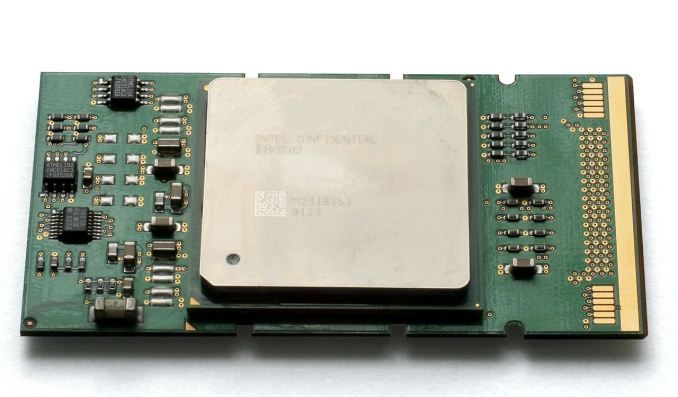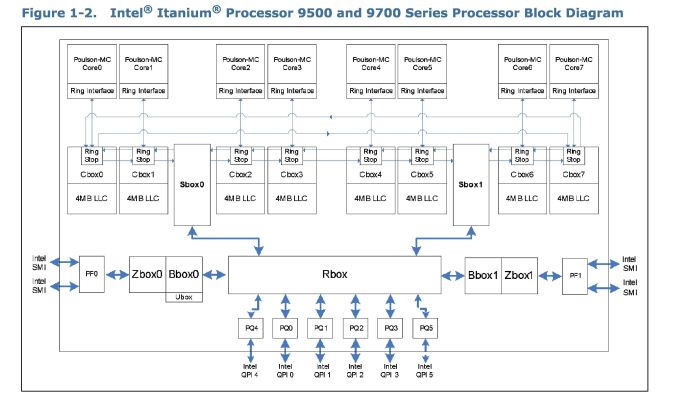Intel’s Itanium Takes One Last Breath: Itanium 9700 Series CPUs Released
by Ian Cutress on May 11, 2017 11:10 AM EST- Posted in
- CPUs
- Intel
- Itanium
- Enterprise
- Enterprise CPUs
- IA-64
- Kittson

One of Intel’s ventures into the historic mainframe space was Itanium: a 64-bit capable processor designed in conjunction with Hewlett Packard. The main reason for Itanium was to run HP-UX and compete against big names, such as Oracle, using a new IA-64 instruction set. The appeal for the original Itanium parts was support for RAS features, ECC, and cores focus on a wide, parallel architecture - the latest cores support 12-wide execution for example. For a short while, there was success: HP’s systems based on Itanium are advertised as high-uptime mission critical servers, and a number of customers cling to these systems like a child clings to their favorite blanket due to the way they are integrated at the core of the company. The main purpose was to compete against other mission critical servers and mainframes based on SPARC and IBM Power.
So when the processors were initially delivered to customers, there was potential. However the initial impression was not great - they consumed too much power, were noisy, and needed over the top cooling. Over the years and generations of Itanium, the march into the x86 enterprise space with x86-64 drew potential Itanium customers away, then followed the drop of Microsoft's support for Itanium in 2008, and Oracle's dropped support in 2011. Xeon offerings were becoming popular, with CPUs incorporating the RAS/ECC features required, and Intel decided to slow down Itanium development as a result. In the meantime, due to the way the market was moving, HP transitioned a good part of its product stack to Xeons. Despite this, legal battles between HP and Oracle ensued given predicted support for HP-UX customers. At this point, there were fewer potential Itanium customers each quarter, although existing customers required support.
Today marks the release of the final known variant of Itanium, the 9700 series, beyond assurance testing. Intel spoke to IDG, stating that this generation, code-named Kittson, would be the final member of the Itanium family. These chips are likely to only end up in HP-based Integrity i6 high-uptime servers running HP-UX, and start at $14500. Hewlett Packard Enterprise has stated previously that it will keep support for Itanium-based products until 2025, with the latest OS update (HP-UX 11i v3 2017) coming in June.
As for the processors themselves, four 9700 processors form the stack, with quad-core and eight-core parts all with hyperthreading, differing in frequency, power, and L3 cache.
| Intel Itanium (Kittson) CPUs | |||||
| Cores/ Threads |
Base Freq |
L3 | TDP | Cost* | |
| Itanium 9760 | 8/16 | 2.66 GHz | 32 MB | 170 W | $4650 |
| Itanium 9750 | 4/8 | 2.53 GHz | 32MB | 170W | $3750 |
| Itanium 9740 | 8/16 | 2.13 GHz | 24 MB | 170 W | $2650 |
| Itanium 9720 | 4/8 | 1.73 GHz | 20 MB | 130 W | $1350 |
*Cost is listed for the equivalent Poulson CPUs.
The base silicon comes in at 3.1 billion transistors, and are made on Intel’s 32nm process. Memory is supported up to DDR3-1067, with two memory controllers but support for scalable memory buffers is present. This is similar to the 9500 series, code-named Paulson. These chips are designed to be purely a drop into previous systems. Intel isn’t announcing an official press release around this, and unlike other ‘new architectures’, there are next to zero improvements. According to the documents, the only change is that the top two SKUs get a clock bump:
There’s probably something new under the hood, perhaps for a specific end-customer, but at this time Intel is directing anything 9700 related to equate to the 9500 series. Customers still interested in Itanium are directed to HPE resellers.
Carousel Image from Konstantin Lanzet (Wikipedia) of Itanium 2 (Poulson)
News Source: IDG













50 Comments
View All Comments
tipoo - Thursday, May 11, 2017 - link
So is Intels Itanium 'flop' still single handedly bigger than all of AMDs cashflow?ImSpartacus - Thursday, May 11, 2017 - link
Oh god, I always get sad over these kinds of comparisons. Poor amd...Nagorak - Thursday, May 11, 2017 - link
Yeah, funny how abusing a monopoly position to freeze out the competition results in great profitability. No surprise that companies continually do it and then pay a few paltry "fines".boozed - Thursday, May 11, 2017 - link
And the hype, oh the hype...That graph on Wikipedia of progressive Itanic sales forecasts almost says it all.
Kevin G - Thursday, May 11, 2017 - link
The Itanium 9700 was supposed to offer some enhancements to the design to improve IPC ever so lightly. Originally it was to arrive on 22 nm as well but Intel moved it back to 32 nm mid stream. While they announced the process node change, they likely decided to dump the IPC improvements it was originally schedule to have and just focused on refining the last design.Kinda funny that Itanium is still on 32 nm despite the rest of Intel's line up being on 14 nm and on track to ship 10 nm parts this year. Even without some IPC enhancements as promosied, a die shrink would have permitted higher clocks and/or more cores in the design. This would have been less embarrassing than the rebrand the few hold overs are getting.
This mimics the death of Alpha after all. The EV7 was replaced by the EV7z which only offered a similar clock speed bump after years of wait. The EV8 had already tapped out but HP put a stop to its release to focus on Itanium. The irony of HP being the last Itanium customer is not lost here.
Kevin G - Thursday, May 11, 2017 - link
And one more thing... it would have been interesting to see Itanium's original goal of socket compatibility with the Xeon E7's. This too was once an announced feature only to be killed off as interest in Itanium dwindled.Intel did meet the goal of using a common chipset with Xeons for while. This makes me wonder if the few minor changes in the Itanium 9700 designs is to offer support some change in the chipsets. IE the 9700 series chips can be used in existing 9500/9300 series sockets but there are going to be a handful of boards that'll only work the 9700 series due to chipset changes.
Reflex - Thursday, May 11, 2017 - link
Man I miss the Alpha. I still have a functioning 533Mhz Alpha CPU/board at home. No use for it though.melgross - Thursday, May 11, 2017 - link
It's a shame that. Microsoft always seems to be at least partly responsible for killing off a number of promising chips designs. By dropping, or refusing, support, it's the death knell.Ian Cutress - Thursday, May 11, 2017 - link
Support is hard. Time, people, resources. Easier to justify droppping as market share dwindles.SarahKerrigan - Thursday, May 11, 2017 - link
Microsoft was only a small Itanium player by the time they exited. Itanium sales were dominated by HP-UX and NSK; Windows and Linux lagged far, far behind, along with VMS and (more distantly) mainframe operating systems.And having worked with it for most of the last decade, I'm not sure how "promising" I'd call IPF. It introduced clever new solutions for problems that don't actually exist, while doing nothing but the same old "eh, just hoist loads" handwaving for the massive issues in-order processors have. At least IBM's in-order cores had run-ahead...